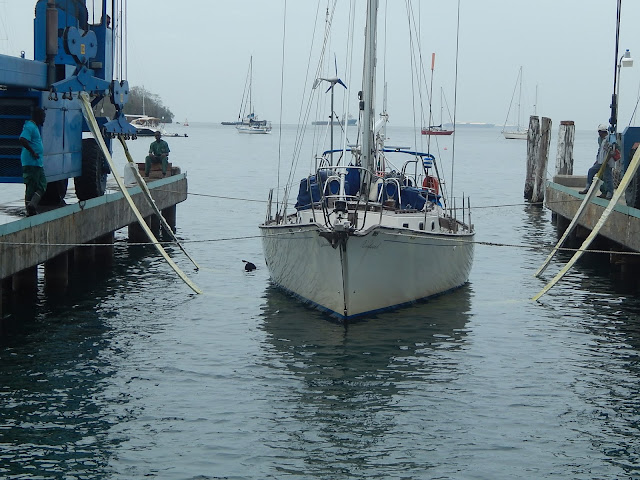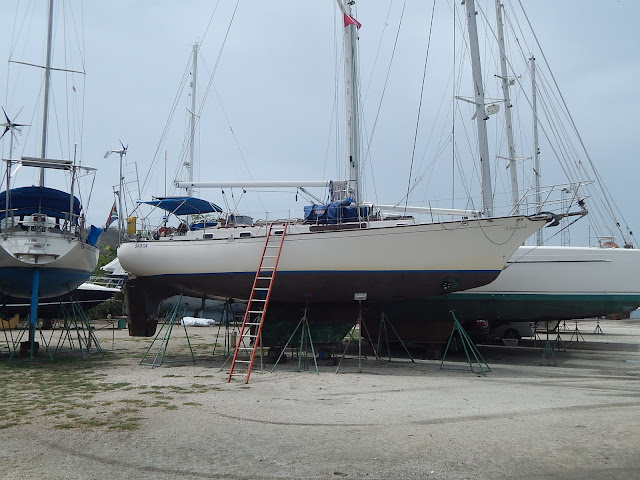This
is a passage that l have looked forward to sailing for many years
after hearing fellow sailors who have completed this route talk about
strong North West setting currents and favourable trade winds all
heading in the right direction with the end goal of arriving in the
Caribbean .
The
reality was a little different in that although there was plenty of
current it wasn't always favourable and at times it was a little
forward or aft of our beam causing our heading and course over ground
to be very different as our autopilot compensated for the effects of
the current . When it was in our favour we clocked good daily runs
without even pressing the boat too hard with our best 24 hour run of
220nm ( 407km for the landlubbers ).
With
the mighty Amazon River and other large powerful rivers off our port
beam the influence that they have hundreds of miles off the coast is
quite remarkable.
At
one point during our passage we were sailing along nicely when we
noticed what initially appeared to be a reef dead ahead of us . For
miles across our bow a line of small wavelets and disturbed water
stretched for as far as the eye could see and once we had entered
this strip of troubled water the effects of a very powerful current
at 90 degrees to our course were felt prompting our autopilot to
change our heading to keep us on track . Visually there is a distinct
change in the colour of the water and the water temp within an
instant changes by up to 3 degrees Celsius . Bear in mind this is
hundreds of miles off the coast in seas that are kilometres deep .
The
best way to describe this scene is to imagine yourself standing on
the banks of a large river in an open plain . We came across these “
rivers of current “ on many occasions during this passage .
At
one point we started seeing rafts of vegetation streaming past us and
later we found out that apparently the plant species is Sargasso Weed
which is now spreading rapidly being swept along in these strong
currents . I am told that if you take a clump of this weed and shake
it many small crustaceans and small living organisms fall out and
apparently these rafts provide protection for small fish that hide in
their growth .
After
rounding the North East corner of Brazil we headed virtually in a
straight line for French Guiana . One night while doing the “
graveyard watch “ l noticed a glow off our port side which after
checking the charts turned out to be the city of Fortaleza . Nothing
amazing about that except that we were 78nm off the Brazilian Coast .
I would never have believed that the artificial light generated from
a city at night would extend that far offshore .
We
were now in an area called the ITCZ commonly referred to as the
doldrums . It is a belt of low pressure that circles the earth near
the equator and it is characterized by erratic weather . Large
cumulus cloud banks which lead to powerful rain squalls , generating
torrential downpours accompanied by strong gusting winds . These
nasties keep you on your toes and keeping a sharp look-out , mainly
on radar at night is key in preventing being caught out unawares with
too much sail up . The standard rule onboard is two reefs in the main
every night at sunset and with our genoa being on a rollerfurler it
is relatively easy to reduce our foresail area quickly . One night we
were nailed by a biggie with winds gusting into the top forties and
rain being blown horizontal to the surface. During the day these
squalls are easy to monitor and at night they appear as large yellow
shapes on our radar screen always with that menacing , angry look. The only good thing about them is that usually they don't last that
long before they overtake you and move on although our biggie stayed
with us for longer than we would have liked because we were slap in
front of it's centre and it moved straight over us headed in the same
direction as we were going .
But
of course the highlight of this passage would be my first crossing of
the Equator at sea behind the wheel of my own boat . A big moment in
my life that we had to film using a GoPro camera because a squall
chose to accompany us up to the line that separates the Northern and
Southern hemispheres . Another large tick off the “ bucket list “.
This
is also an area with a very interesting seabed . Huge seamounts (
mountains ) rising up from the floor of the ocean to just short of
the surface .
One
named Banco Canopus on our chart rises from 3000m ( 3kms ) to just
50m from the surface with its one face almost sheer to the bottom .
It put a new perspective on how submarines would have to navigate to
avoid colliding with one of these obstructions hundreds of miles at
sea .
During
the entire passage flying fish were in abundance , thousands of them
with some unfortunate enough to land up on our decks and even in our
cockpit . The special moments were when we had dolphins popping in
for a visit as they almost seem excited to see you . Generally we
spot them from a distance jumping clear of the surface while taking a
good look at us , but once they reach our boat they tuck in and surf
our bow wave . The best seat in the house is on the bowsprit and
although l have enjoyed many contacts with dolphins over the years ,
seeing them that close turning on their sides and making eye contact
is something to be cherished .
Finally
Trinidad came into view and we sailed the length of the North Coast
of the island heading for Boca de Monos the passage that leads into
the Gulf of Paria and our final destination Chaguaramas where we tied
up to the Customs Dock and checked into the country .
Our
2200nm voyage had gone really well and my good mate Philippe Gouffon
turned out to be an excellent sailing companion , treating the boat
like his own and always up to the task . He played a big part in
making this passage a success .
What
lies ahead is a number of seasons of cruising and exploring the
Caribbean Islands , a mouthwatering prospect .



























































